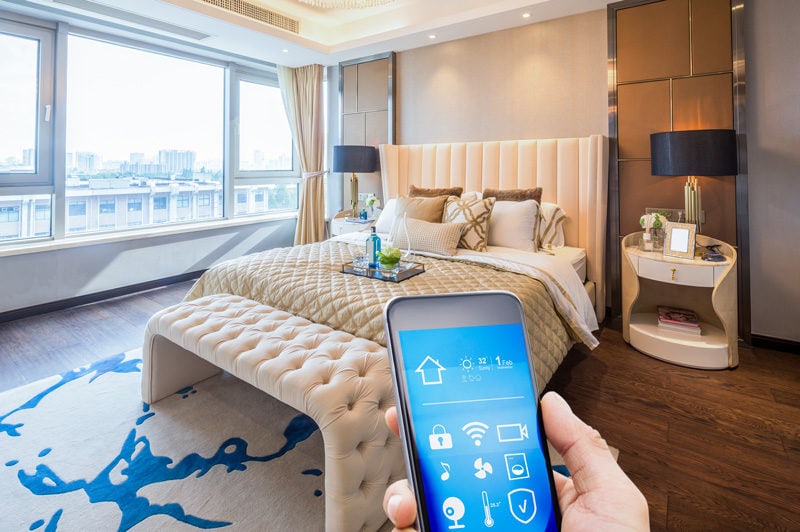Why Panic Buttons Are An Integral Part of Every Hotels IoT Strategy
by React Mobile, on Aug 30, 2019 12:01:00 PM

What once seemed like a futuristic concept, is now a reality. IoT — that is, the Internet of Things — has been steadily transforming our world over the past few years, and it shows no sign of slowing down. In fact, studies show that as of 2020, there will be 20.4 billion connected “things”. Phocuswire reports that in today’s business environment, 94% of organizations that have implemented IoT solutions have seen a return on their IoT investments with benefits that include tracking assets in real-time, shorter wait times for customers, energy-efficient environments, and personalized experiences.
The Internet of Things (IoT) is used to describe the enhanced connectivity we now experience within everyday devices and appliances that would not typically boast such capabilities. In layman’s terms, it’s the evolution
from regular devices to ‘smart’ devices, which are able to send and receive data while communicating with each other. Pretty much any physical object can be transformed into an IoT device if it can be connected to the internet and controlled that way. In many cases, this helps to improve automation of certain tasks or functions and can also allow for multiple devices to be remotely controlled or monitored from one centralized place (such as a phone or a tablet).
So, what are hotels investing in when it comes to their IoT strategy?
‘Smart’ Guest Experiences
The hospitality industry has been quick to recognize the importance of developing an IoT strategy, as guests typically crave the comforts of their home within the more luxurious confines of a hotel room. IoT devices lend to a more customized experience, which not only creates a more personalized guest experience but also allows hotels to reduce costs and tap into the power of automation.
With an IoT strategy in place, guests can enjoy the customized comfort of automated ‘smart rooms’, within which guests are able to control many of the room’s features from their mobile phone, or from a provided tablet. Oftentimes, this allows for the remote control of temperature, light settings, television and entertainment systems and, in some cases, the additional convenience of a voice-activated assistant. IoT functionality also allows for the integration of guests’ personal gadgets, as mobile check-in, keyless entry and seamless digital communications and touch-points continue to become the new norm. Experts agree that the smartphone will soon be the remote control of the entire hotel room and rather than building technology from the ground up, most hotels and technology brands are working with partners and integrations to bring their IoT guest rooms to life.
But what if we told you this was only the beginning?
‘Smart’ Staff Safety
While hotels work to build out their IoT strategy as these devices and their breadth of functionality continue to evolve, it’s time for hoteliers to widen their scope of consideration. While the use of IoT connectivity is undeniably integral to the operational framework of a hotel (smart hotel rooms, mobile check-in, predictive maintenance, and more) it boasts another, critical application. The Internet of Things has also made it possible for hotels to implement an array of new security technologies. From AI security cameras to biometric access controls and panic buttons, IoT devices can help to protect both guests and employees.
The on-going safety of hotel employees has been a rather important conversation over the last year, as hotels continue to overhaul their existing safety policies. Realizing that hospitality staff often face especially vulnerable scenarios while on the job which can implicate their safety and well-being, hoteliers are finally placing a dedicated emphasis on employee safety with the implementation of new-age panic buttons as part of an integrated smart hotel strategy.
Today’s panic buttons are a far cry from their legacy counterparts of the past, leveraging the power of IoT to empower hotels to establish a truly connected safety platform that advocates for the on-going well-being of their staff, on and off property, 24/7 through GPS-enabled monitoring. These connected devices enable hotels to easily track, respond to and manage situations that require immediate attention. IoT solutions can even be used to detect suspicious behavior and trespassers. Integrated panic button platforms enable better safety overall by ensuring real-time insights into these key areas. Any issues that arise can be addressed immediately, assuring hotel employee peace of mind as well as compliance with safety regulations. Often, if left to human reporting alone, many problems can slip through the cracks as they are either unreported or under-reported.
Considering work-related injuries totaled 4.5 million in 2017, which cost an estimated $161.5 billion in medical expenses, wage and productivity losses, administrative expenses (and more), helping hoteliers to pro-actively manage preventable threats has never been more important. While IoT-enabled safety platforms cannot stop dangerous circumstances altogether, they do represent an integral, actionable solution for the betterment of hospitality staff safety, both now and in the future.
The IoT shines at keeping an eye on things; collecting data by means of connected devices and platforms, which makes it an ideal fit for safety devices. As IoT technology continues to improve, hoteliers will be able to equip their staff with a range of safety-focused devices that will empower staff safety, monitor physical conditions and ensure help is always close by in case of an emergency. React Mobile is leading the charge when it comes to implementations and technology partnerships with hotels and brands such as Aruba, Honeywell, Ruckus, and many more. Further to the possibilities enabled by the smartphone, more IoT-enabled wearables and objects are coming to market. By continuing to connect machines, data and people together, leveraging IoT, companies can continue to make great strides to improve safety in the hospitality workplace.
Learn about the Evolution of Employee Staff Safety Devices in our free guide:


